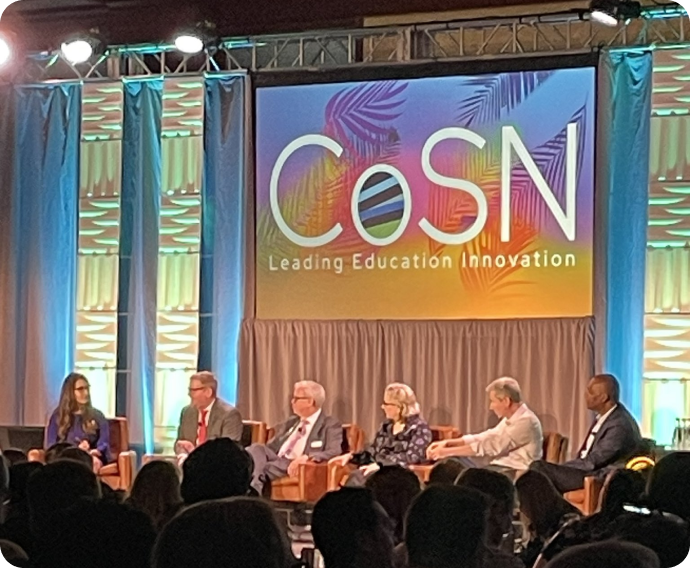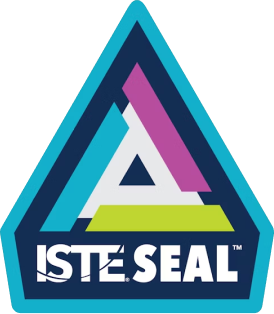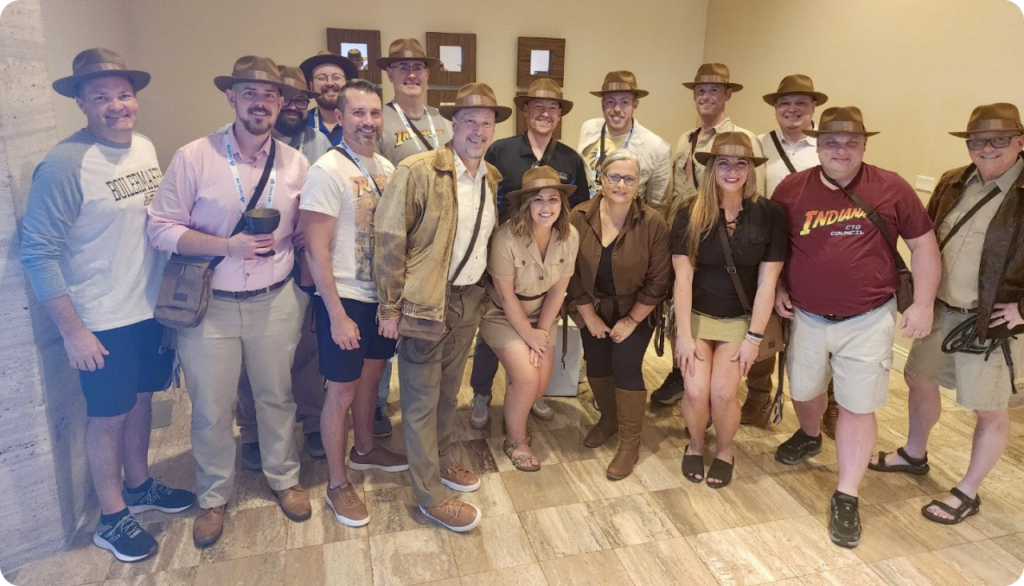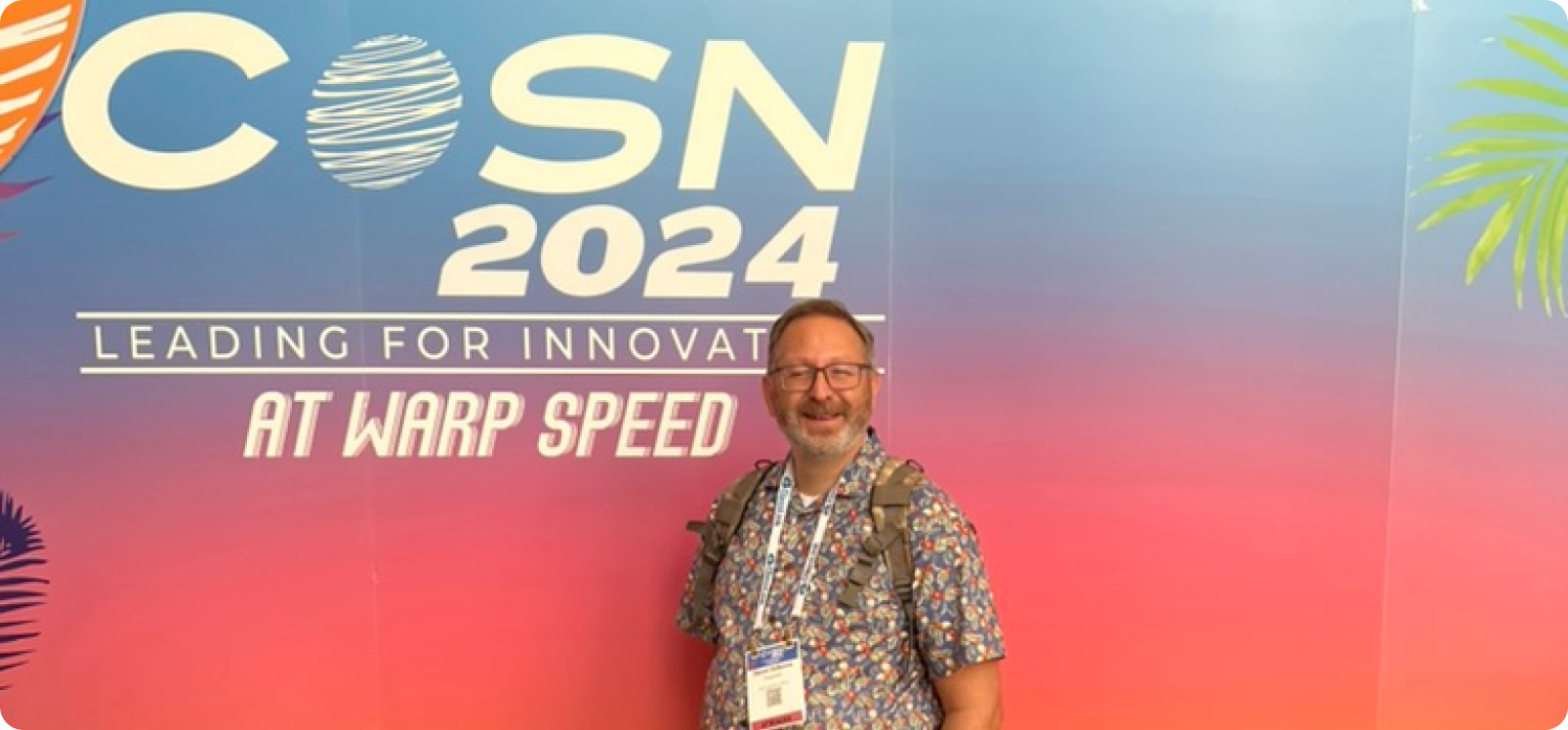Was the CoSN conference worth attending? DEFINITELY! Did I gain a broader and deeper context for the current state of EdTech? YES! Can experience design and usability have an impact on student learning? DOUBLE YES! Below are my key takeaways from the conference.
1. K-12 & Higher Ed Leadership are Embracing AI
AI is here and it’s changing the way students conduct research, solve problems, and learn. The use of AI in learning had strong support during the general session panel discussion with EdTech leaders Jean-Claude Brizard (Digital Promise Global), Richard Culatta (ISTE + ASCD), Julia Fallon (SETDA), Keith R. Krueger (CoSN), and David R. Schuler (AASA). This sentiment was echoed with positive applause throughout the discussion by 100’s of attendees in the audience.

The “But kids will cheat!” boogie man was disarmed in part by an interesting study by Denise Pope at Stanford. Survey data found pre and post-AI cheating remained the same at 60 – 70%. It’s clear that AI is a disruptive technology that will require new processes, guardrails, and policies… but so did the use of calculators. When I was in high school, calculators were not OK because they were seen as cheating devices. Now now they are accepted and even required during some math tests.
The challenge we face is how use AI to enhance learning while maintaining core knowledge, critical thinking, and creativity. Contact us to learn more.
2. EdTech has a Usability Gap
During COVID I had a chance to observe my middle school-aged children’s frustration with a host of EdTech products and platforms. As a user researcher, I couldn’t help but engage in contextual inquiry (observation) and usability evaluation (assessment) as they participated in class and completed assignments. My kids were having a hard time and their learning suffered.
As an industry, we need to acknowledge and embrace the importance of usability in digital learning. At CoSN I found high variability on how attendees understood and valued usability. I heard their struggles, solutions, and in some cases siloed unawareness. The really great thing was that people’s ears perked up and they were interested in learning about the importance of usability.
District and Higher Ed Leaders are starting to understand that great interfaces facilitate learning and poor ones hinder it. The organizational maturity and ability to devote resources towards ensuring highly usable products varies. Smaller rural districts are struggling to properly select and manage their EdTech stack. Larger, more well-funded districts have full teams that have responsibility to ensure the best products are selected. In both cases, product usability is gaining attention.
Vendors seem to be feature-focused. Affording teachers and students with innovative functionality is important. However, the missing aspect is whether those features are usable: do interfaces facilitate learning or do they produce moments of pause that break a student’s flow? After speaking with just about every one of the 80+ vendors, it was clear that the importance of product usability has not been fully embraced. A surprisingly high number of vendors didn’t know what UX was!

Professional Organizations are beginning to promote usability as a critical aspect in EdTech evaluation. Trusted organizations like The International Society for Technology in Education offer product certifications that include an assessment of usability. Their ISTE Seal (https://iste.org/iste-seal) provides institutions with insights on whether a product is usable. Institutions are even beginning to include these certifications as valuation components in RFPs.
Usable interfaces in EdTech facilitate learning flow. Its great for students and a marketable differentiator for vendors. Contact us to learn more.
3. Common Goals Align All Players
At CoSN 2024, institutions, professional organizations, and vendors came together to share, learn, and innovate “At Warp Speed.” I was very happy to see that everyone was driven to provide great learning opportunities to our kids. Leadership from a number professional organizations such as ISTE, SEDTA, and Digital Promise were present and interacting with attendees throughout the conference. Seeing these organizations working together with common purpose felt good.
There was also an unexpected sense of camaraderie and fun amongst amongst the participants. They wanted to be there. Many of the CoSN state chapter participants wore coordinated outfits at events. My favorite was the crew from Indiana:

First Time Attendee
We have been in the EdTech space for some time, but never had a chance to attend a Consortium of School Networkers conference. We had a great time for a number of reasons:
- Presentations were high-quality, relevant, and interactive. I was able to connect with the presenters and have additional conversations.
- The attendees were friendly and knowledgeable. We had a chance to talk with a variety of superintendents, CTOs, IT & security leaders, and teachers in every size institution. Hearing their struggles and solutions, especially surrounding usability was very helpful.
- CoSN has a unique approach with vendors. They encouraged us to participate in sessions and interact directly with attendees. All booths were equal in size consisting of a backdrop and a single table that extended into the main space. They made it simple for the vendors and invited more conversation approachable booth setups.
The CoSN conference was highly valuable and I recommend it to anyone in the EdTech and Education space. Look for us at next year’s conference.



